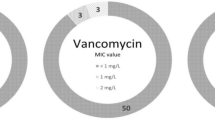Abstract
On the basis of the MICs of methicillin and oxacillin, 975 clinical isolates ofStaphylococcus aureus were categorized as having resistance, borderline susceptibility or full susceptibility to penicillinase-resistant penicillins (PRPs). The borderline phenotype accounted for 122 isolates (12.5 %), whereas 562 isolates were fully susceptible and 290 resistant; one remaining isolate had resistance to methicillin and borderline susceptibility to oxacillin. Reductions in the MICs of methicillin and oxacillin in the presence of sulbactam were greater in strains with borderline PRP susceptibility than in fully susceptible or resistant isolates. Over 99 % of fully PRP-susceptible strains, 93 % with borderline susceptibility and 71 % of resistant strains were susceptible to ampicillin/sulbactam. The production of β-lactamase, assayed in all strains using nitrocefin as substrate, could be detected without prior induction in 729 strains and after induction only in another 156 strains. With only two exceptions, the β-lactamase negative strains were part of the fully PRP-susceptible group of organisms (88 of 562 isolates). Among the borderline isolates, strong β-lactamase reactions were encountered with particular frequency, but not in all strains and not exclusively in borderline strains. Although associated with the majority of borderline strains, β-lactamase hyperproduction thus did not appear to be an essential feature of the borderline phenotype. The results obtained may have implications for laboratory and clinical medicine, also in the light of recent findings suggesting that other mechanisms besides β-lactamase hyperproduction may account for borderline susceptibility to PRPs.
Similar content being viewed by others
References
Thornsberry C, Culver DH, Hughes JM Methicillin-resistantStaphylococcus aureus: incidence and susceptibility to antimicrobial agents. In: Shimada K, Tomasz A (ed): Methicillin-resistantStaphylococcus aureus. University of Tokyo Press, Tokyo, 1986, p. 7–12.
McDougal L, Thornsberry C The role of β-lactamase in staphylococcal resistance to penicillinase-resistant penicillins and cephalosporins. Journal of Clinical Microbiology 1986, 23: 832–839.
Montanari MP, Tonin E, Biavasco F, Varaldo PE Further characterization of borderline methicillin-resistantStaphylococcus aureus and analysis of penicillin-binding properties. Antimicrobial Agents and Chemotherapy 1990, 34: 911–913.
Chambers HF, Archer G, Matsuhashi M Low-level methicillin resistance in strains ofStaphylococcus aureus. Antimicrobial Agents and Chemotherapy 1989, 33: 424–428.
Sierra-Madero JG, Knapp C, Karaffa C, Washington JA Role of β-lactamase and different testing conditions in oxacillin-borderline-susceptible staphylococci. Antimicrobial Agents and Chemotherapy 1988, 32: 1754–1757.
Tomasz A, Drugeon HB, de Lencastre HM, Jabes D, McDougal L, Bille J New mechanism for methicillin resistance inStaphylococcus aureus: clinical isolates that lack the PBP 2a gene and contain normal penicillin-binding proteins with modified penicillin-binding capacity. Antimicrobial Agents and Chemotherapy 1989, 33: 1869–1874.
Barg N, Chambers H, Kernodle D Borderline susceptibility to antistaphylococcal penicillins not conferred exclusively by the hyperproduction of β-lactamase. Antimicrobial Agents and Chemotherapy 1991, 35: 1975–1979.
Gerberding JL, Miich C, Liu HH, Chambers HF Comparison of conventional susceptibility tests with direct detection of penicillin-binding protein 2a in borderline oxacillin-resistant strains ofStaphylococcus aureus. Antimicrobial Agents and Chemotherapy 1991, 35: 2574–2579.
Massidda O, Montanari MP, Varaldo PE Evidence for a methicillin-hydrolyzing β-lactamase inStaphylococcus aureus strains with borderline susceptibility to this drug. FEMS Microbiology Letters 1992, 92: 223–227.
McMurray LW, Kernodle DS, Barg N Characterization of a widespread strain of methicillin-susceptibleStaphylococcus aureus associated with nosocomial infections. Journal of Infectious Diseases 1991, 162: 759–762.
Varaldo PE, Satta G Staphylococcal diseases. In: Balows A, Hausler WJ, Lennette EH (ed): Laboratory diagnosis of infectious diseases, principles and practice. Volume 1. Springer Verlag, New York, 1988, p. 473–482.
National Committee for Clinical Laboratory Standards Methods for dilution antimicrobial susceptibility tests for bacteria that grow aerobically. 2nd edition. Approved standard M7-A2. NCCLS, Villanova, PA, 1990.
Varaldo PE The ‘borderline methicillin-susceptible’Staphylococcus aureus. Journal of Antimicrobial Chemotherapy 1993, 31: 1–4.
Smith JMB Terminology ofStaphylococcus aureus strains showing decreased susceptibility to methicillin. Journal of Antimicrobial Chemotherapy 1992, 29: 219–232.
Kline MW, Mason EO, Kaplan SL Outcome of heteroresistantStaphylococcus aureus infections in children. Journal of Infectious Diseases 1987, 156: 205–208.
Boyce JA, Medeiros AA, Rimland D Detection and treatment of infections caused byStaphylococcus aureus resistant to penicillinase-resistant penicillins. Journal of Infectious Diseases 1988, 157: 602–603.
Liu H, Buescher G, Lewis N, Snyder S, Junkind D Detection of borderline oxacillin-resistantStaphylococcus aureus and differentiation from methicillin-resistant strains. European Journal of Clinical Microbiology & Infectious Diseases 1990, 9: 717–724.
Massanari RM, Pfaller MA, Wakefield DS, Hammons GT, McNutt LA, Woolson RF, Helms CM Implications of acquired oxacillin resistance in the management and control ofStaphylococcus aureus infections. Journal of Infectious Diseases 1988, 158: 702–709.
Zierdt CH, Hosein IK, Shively R, MacLowry JD Phage pattern-specific oxacillin-resistant and borderline oxacillin-resistantStaphylococcus aureus in U.S. hospitals: epidemiological significance. Journal of Clinical Microbiology 1992, 30: 252–254.
Liu H, Lewis N Comparison of ampicillin/sulbactam and amoxicillin/clavulanic acid for detection of borderline oxacallin-resistantStaphyloccus aureus. European Journal of Clinical Microbiology & Infectious Diseases 1992, 11: 47–51.
Thauvin-Eliopoulos C, Rice LB, Eliopoulos GM, Moellering RC Efficacy of oxacillin and ampicillin-sulbactam combination in experimental endocarditis caused by β-lactamase-hyperproducingStaphylococcus aureus. Antimicrobial Agents and Chemotherapy 1990, 34: 728–732.
Author information
Authors and Affiliations
Rights and permissions
About this article
Cite this article
Varaldo, P.E., Montanari, M.P., Biavasco, F. et al. Survey of clinical isolates ofStaphylococcus aureus for borderline susceptibility to antistaphylococcal penicillins. Eur. J. Clin. Microbiol. Infect. Dis. 12, 677–682 (1993). https://doi.org/10.1007/BF02009379
Issue Date:
DOI: https://doi.org/10.1007/BF02009379




